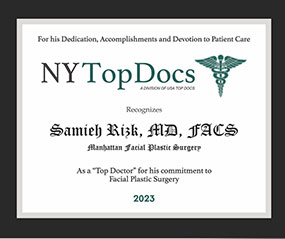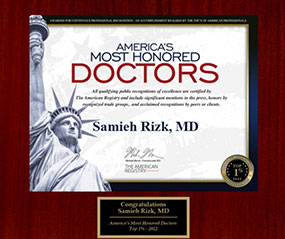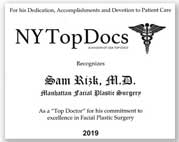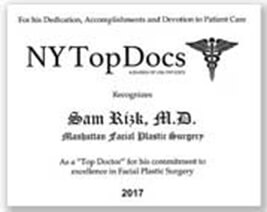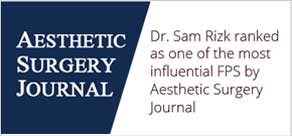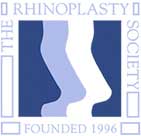What Is Nasal Mohs Surgery Reconstruction?
Skin cancer on the nose is not only a physically challenging experience but often emotionally traumatic as well, potentially leaving patients with visible scars that impact their confidence and sense of self. Dr. Rizk understands the deep, personal toll this can take. With Mohs surgery, cancerous tissue can be removed with minimal loss of surrounding healthy tissue, yet this still leaves many patients facing open wounds and visible changes to their appearance. Dr. Rizk’s compassionate approach and expertise in nasal reconstructive surgery after cancer aim to restore both the physical form and emotional well-being of each patient, helping them regain a sense of wholeness and confidence.
Depending on the type of cancer that’s been removed and the amount of tissue loss, rhinoplasty surgeon Dr. Rizk will determine which technique will be most suitable for the reconstruction. This could include using tissues from other parts of the body (such as the rib) or using a reconstructive technique such as a skin flap, bone graft, cartilage graft, facial implant or fat transfer to replace missing tissue.
In addition to considering what type of surgery needs to be performed, Dr. Rizk will also consider the patient’s aesthetic goals and desired outcomes. He understands that a person’s nose is often their most prominent facial feature, and as such takes extra care to ensure it is reconstructed to look natural and aesthetically pleasing.

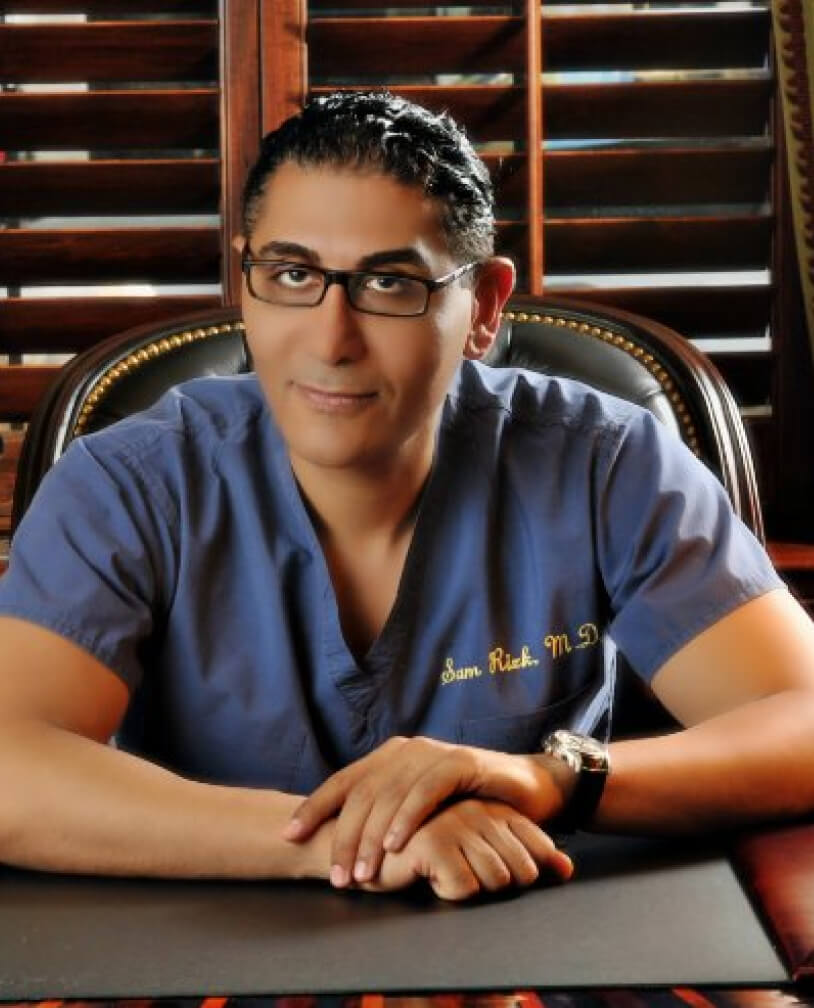
Meet Dr. Sam Rizk | A NYC Board-Certified Facial Plastic Surgeon
Dr. Sam Rizk, a double board-certified facial plastic and reconstructive surgeon, spent 4 years of his surgical training in nose and face cancer reconstruction at the renowned hospitals – Memorial Sloan-Kettering Cancer Center and Cornell Medical School/New York Hospital Center. Dr. Rizk continues to teach and lecture on his techniques and innovations at Cornell/New York Hospital conferences as well as national and international plastic surgery conferences. Many of Dr. Rizk’s innovations have been published in peer-reviewed plastic surgery journals. Needless to say, he is well-respected in the field and his work is highly desired.
Removal of Skin Cancer and Tumors in New York
Typically, if a skin cancer needs to be removed from the nose, that surgery is performed by a dermatologist. However, for best cosmetic results, the dermatologist should work in tandem with a plastic surgeon, such as Dr. Sam Rizk, whose practice consists of 10-15 per cent reconstructive surgery after either cancer removal or trauma to the face and nose.
Dr. Rizk’s nose reconstruction procedures are coordinated with the dermatologist ahead of time, which means that you can undergo the reconstruction on the same day as the excision. The excision is performed by the dermatologist and the patient is sent over to Dr. Sam Rizk’s center for the nose cancer surgery reconstruction.
Here are some examples of nose excision procedures that will need Dr. Rizk’s care and attention for nose reconstruction after cancer:
Mohs Excision | Plastic Surgery After Mohs on Nose
Skin cancers are referred to Dr. Sam Rizk typically after a Mohs excision is done by a dermatologist. A Mohs excision is a micrographic excision intended to preserve normal tissue by examining and mapping surgical borders under the microscope. Dr. Rizk is experienced in reconstructing the external nose after a skin cancer removal.
Removal of Basal Cell Carcinoma (BCC)
BCC typically grows slowly, but it may require multiple stages of basal cell carcinoma nose reconstruction in order to restore the nose and its function. Dr. Rizk will advise you on the best approach for you basel cell nose surgery.
Squamous Cell Carcinoma (SCC)
SCC is a more dangerous type of skin cancer, and it can spread to other parts of the body if not treated. Dr. Rizk is experienced in restoring form and function to the nose following SCC excision.
Malignant Melanoma
Malignant melanomas require a more comprehensive approach to reconstruction, as they can have significant effects on the surrounding tissue and may need to be reconstructed in several stages.
Benign Tumors | Hemangiomas and Nasal Polyps
Benign tumors such as hemangiomas may or may not require surgical excision, and nasal polyps can also be removed surgically.
Wide Local Excision | Removal of Internal Nose Cancers
The amount of tissue damage depends on the size and location of the tumor as well as how much normal tissue needs to be removed. Sometimes the tumor is in the wall that separates the two sides of the nasal cavity (the nasal septum). In these situations, the surgeon might need to remove part or all of the nasal septum. Dr. Rizk is experienced in reconstructing the internal nose after wide local excision of an internal cancerous tumor.
Skin Cancer Removal on Nose
For cancers on the side of the nose affecting the skin, your surgeon can usually remove the affected part. Doctors call this operation a partial rhinectomy. Your surgeon may need to remove all of your nose if the cancer has spread widely into your nose tissue. This operation is called a total rhinectomy.
Pre-Operative Consultation with NYC Expert, Dr. Rizk
A pre-operative consultation with Dr. Rizk is essential for personalized nose reconstruction planning. During this meeting, Dr. Rizk evaluates your condition, explains the Mohs surgery reconstruction process, and addresses your concerns. This thorough approach ensures a clear understanding of the procedure and helps achieve the best possible balance of function and aesthetics.
- Meet NYC expert Dr. Rizk in his Manhattan Office.
- Receive an evaluation of your condition and surgical needs.
- Learn about the Mohs surgery reconstruction process.
- Discuss your questions and concerns directly with Dr. Rizk.
- Understand the procedure and expected outcomes for restoring function and appearance.
More on Rhinoplasty
- Revision Rhinoplasty
- Skin Care After Rhinoplasty
- Ethnic Rhinoplasty
- Septoplasty & Sinus Surgery
- Piezo Rhinoplasty
- Finesse Rhinoplasty
Nose Reconstruction After Cancer Removal: How It Is Done?
Dr. Rizk prioritizes both function and aesthetics in every nasal reconstruction, understanding how crucial it is for patients to feel confident in their appearance. Using techniques like skin flaps, cartilage grafts, and advanced facial implants, he meticulously restores the natural contours and proportions of the nose, aiming for results that blend seamlessly with each patient’s features. His goal is to help patients regain not only nasal function but also the confidence to look and feel like themselves again.
Localized Tissue Flaps | The Preferred Option
The local flap technique involves taking tissue from another area near the nose, such as the forehead, and using it to reconstruct the nose. This technique is often used when only a small portion of the nose needs to be reconstructed or replaced. This may take the form of a flap where tissue is rotated into the defect, advanced into the defect or moved into the defect using a combination of rotation and advancement. The advantage of this technique is that it doesn’t require the use of a skin graft, and it also preserves much of the patient’s existing tissue.
Skin and Cartilage Grafting | Not Enough Local Tissue Available
When local tissue flaps from surrounding tissue aren’t enough to rebuild the nose, skin grafts can be used. Skin grafts involve taking skin from another area of the body, such as the thigh, and attaching it to the nose. The cartilage graft involves taking cartilage from another part of the body, such as the ear, and using it to rebuild the nose. A composite graft is composed of skin and cartilage (usually harvested from the patient’s ear) and this is also an option.
Major Grafting | Collapsed Nasal Bridge Reconstruction
Sometimes in major cancer reconstructions additional rib (costal) cartilage from a tissue bank and temporalis fascia (soft tissue obtained from above patient’s ear) may be used to build a collapsed nasal bridge from cancer removal. If internal nasal structures have been removed due to cancer, the nose can collapse due to loss of support and in severe cases Dr. Rizk recommends the use of costal (rib) cartilage from a tissue bank, to build the collapsed structures which may involve the nasal tip, bridge, or both.
Forehead Flap Surgery as Last Resort
The forehead flap technique involves taking a portion of the scalp and flipping it to the nasal area, creating a pocket of skin that can then be used to shape the new nose. This technique is usually only considered a last resort, due to its complexity and potential for significant scarring at both donor and recipient sites. More specifically, the forehead flap is a last resort as it must remain attached to the nose with a tissue bridge (pedicle) until the new forehead tissue in the nose is able to obtain blood supply from the nose.
Factors Influencing the Reconstructive Approach
Multiple factors shape the reconstructive approach for nose reconstruction. These include the size, depth, and location of the defect, the patient’s overall health, skin type, and personal preferences. Dr. Rizk weighs each element to optimize both function and appearance. Understanding these factors provides insight into the reconstruction process.
Size and Location of Nasal Wound
The size and location of the nasal wound are critical in determining the reconstructive approach. Larger wounds or those in complex areas, such as the nostrils or nasal tip, require advanced techniques to restore both function and appearance effectively. Dr. Rizk carefully assesses these factors to achieve the best possible outcome.
Patient’s Anatomy and Aesthetic Goals
Dr. Rizk evaluates facial structure, skin characteristics, and nasal function while discussing the patient’s desired appearance. This comprehensive approach ensures the procedure addresses both functional needs and cosmetic preferences, achieving a result that aligns with the patient’s vision. This approach merges clinical expertise with patient expectations for a satisfying resolution.
Surgeon Expertise
Surgeon expertise is crucial for successful nose reconstruction after cancer. With Dr. Rizk’s two decades of experience, advanced techniques, and commitment to precision, you’re under the care of a highly skilled professional. He ensures function is preserved and aesthetics are restored, providing renewed confidence and overall well-being.
The Nasal Mohs Surgery Reconstruction Recovery Process
After surgery, patients usually stay in the hospital for a few days before returning home, where they will have to take it easy and avoid strenuous activity. Swelling and bruising around the eyes and nose is expected, while normal activities can usually be resumed after 8 weeks.
The recovery process takes time as the new nose must heal properly; however, with Dr. Rizk’s expertise, most of his patients are thrilled with their results. The healing process is different for each person, and scarring also depends on how well the body heals. After surgery, you should follow all post-surgical instructions to ensure optimal results.
Potential Complications with Nose Reconstruction After Cancer
Potential complications with nose reconstruction after cancer include infection, bleeding, scarring, and suboptimal healing. Additionally, some patients might experience nasal obstruction, breathing difficulties, or dissatisfaction with the final result. Maintaining clear communication with your surgical team and diligently adhering to post-operative care instructions can significantly minimize these risks, ensuring a smooth and successful recovery process.
Asymmetry Correction and Scar Tissue Reduction After Reconstruction
Asymmetry is often a problem after rhinoplasty surgery, whether it be from an injury, prior surgery or due to the removal of skin cancer. Dr. Rizk strives for perfection and works diligently to achieve the best results for each patient. If you are unhappy with your appearance after reconstruction, Dr. Rizk may be able to use a combination of forehead flap, cavitary reconstruction and other techniques to correct any asymmetry.
Cosmetic Rhinoplasty
When using skin from other parts of the face to reconstruct the nose, the result may create some asymmetry as the skin of the face is thicker than that of the nose. After a year has passed from the initial nasal reconstruction, some patients may elect to do a cosmetic rhinoplasty to correct the asymmetry. Cosmetic rhinoplasty would involve debulking or thinning out the thicker tissue that was transferred to the nose from surrounding tissue.
Laser Treatments
Laser treatment can help to improve the appearance of scars on the nose. By using a fractional laser, Dr. Rizk can break down scar tissue and stimulate collagen production to improve the appearance of scars. However, patients should be aware that results may vary depending on how the body heals from surgery. Scars may be decreased with Dr. Rizk through the use of either a fractionated CO2 laser, microdermabrasion or both.
Reduction of Scar Tissue Impeding Breathing
Some intranasal functional surgery may be performed to remove bulky tissue/scar tissue which may be blocking the patient’s breathing. This can be performed sooner than a year if an internal deformity or scar tissue is visible to improve the patient’s quality of life.
Interested in Skin Cancer Removal On The Nose?
Nose reconstruction after cancer is a complex procedure that requires great skill and experience. Dr. Rizk has extensive experience in this area and his patients are delighted with their results. If you or a loved one has been affected by nasal or skin cancer on the nose, don’t hesitate to reach out to Dr. Rizk for a consultation today! He can provide the expertise needed to help restore your nose.
Dr. Rizk in the Media
Awards & Certifications

By Dr. Sam S. Rizk, M.D., FACS.
Dr. Rizk is a double-board-certified facial plastic surgeon who specializes in rhinoplasty surgery and is a recognized expert on the latest advances in facial plastic surgery techniques. He performs a range of facial plastic surgeries at his New York practice.

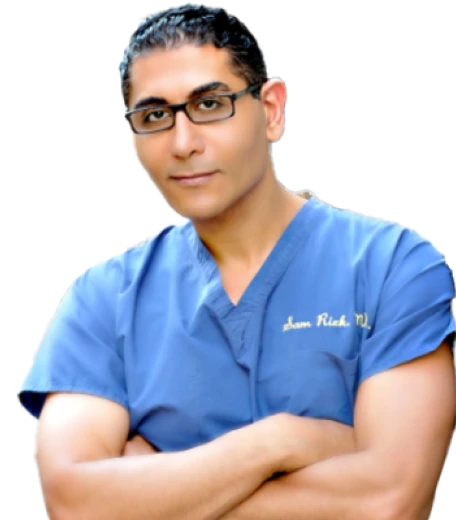
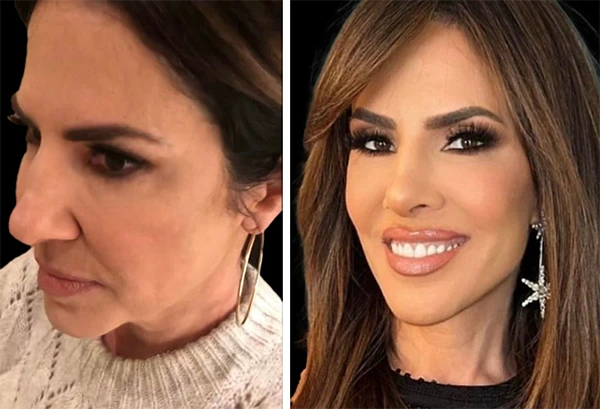

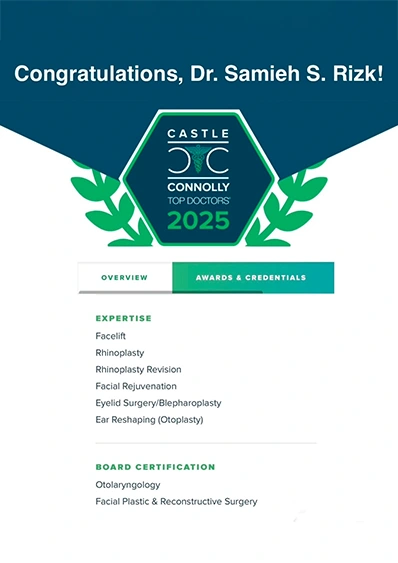
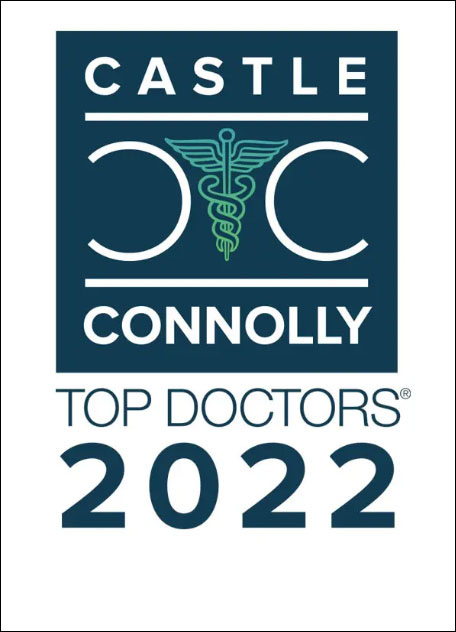
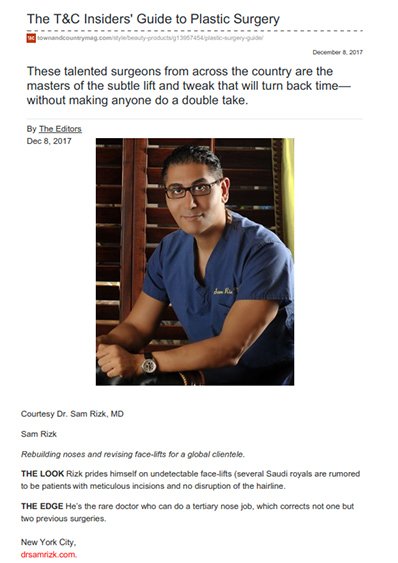

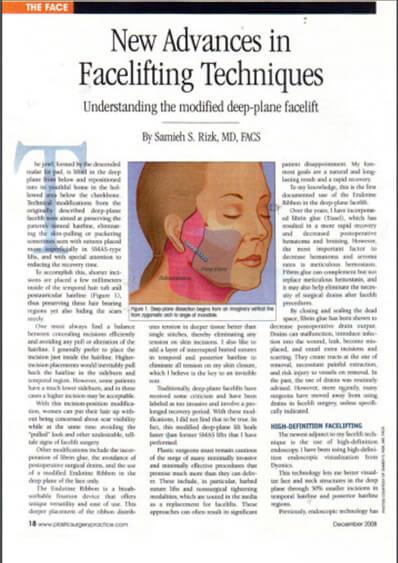


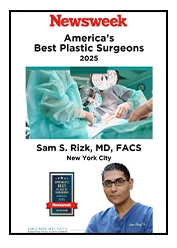
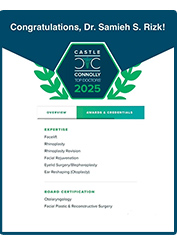
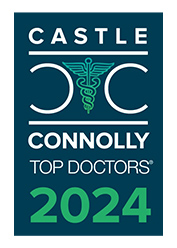

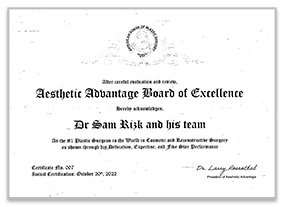
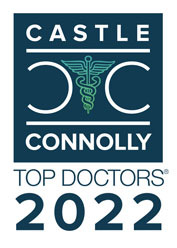

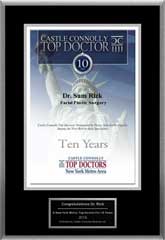
2.jpg)
